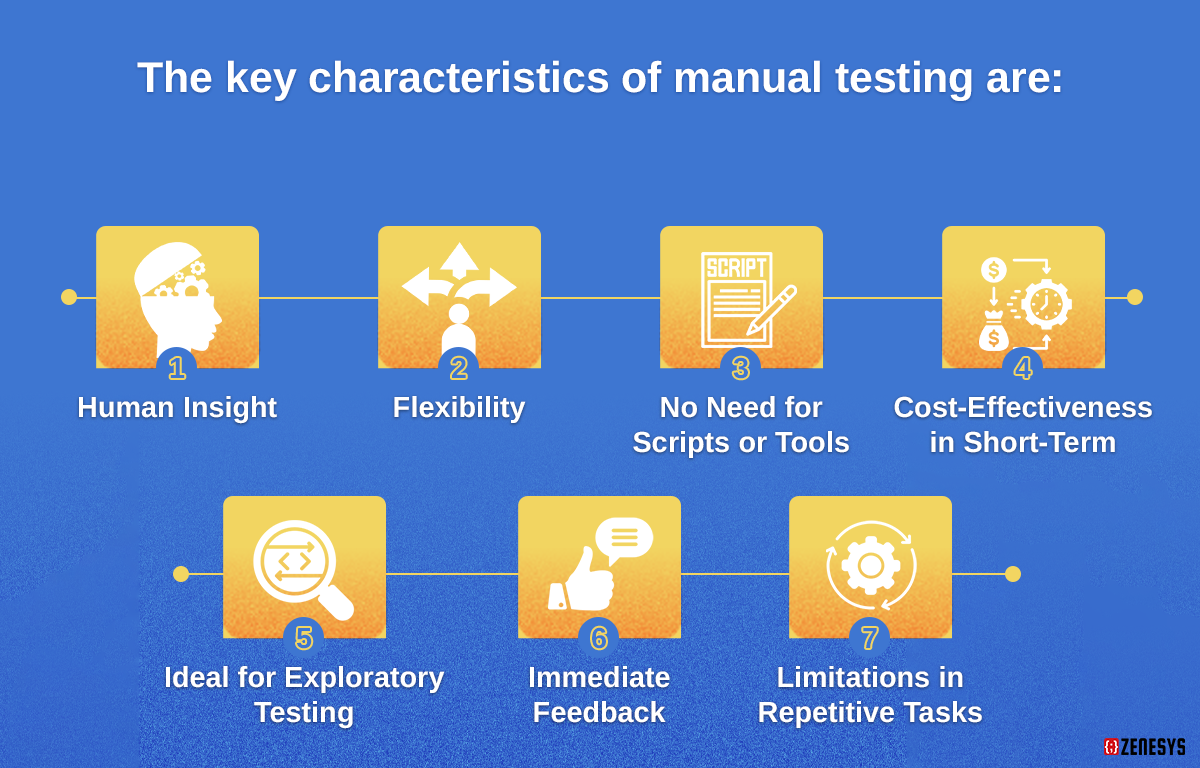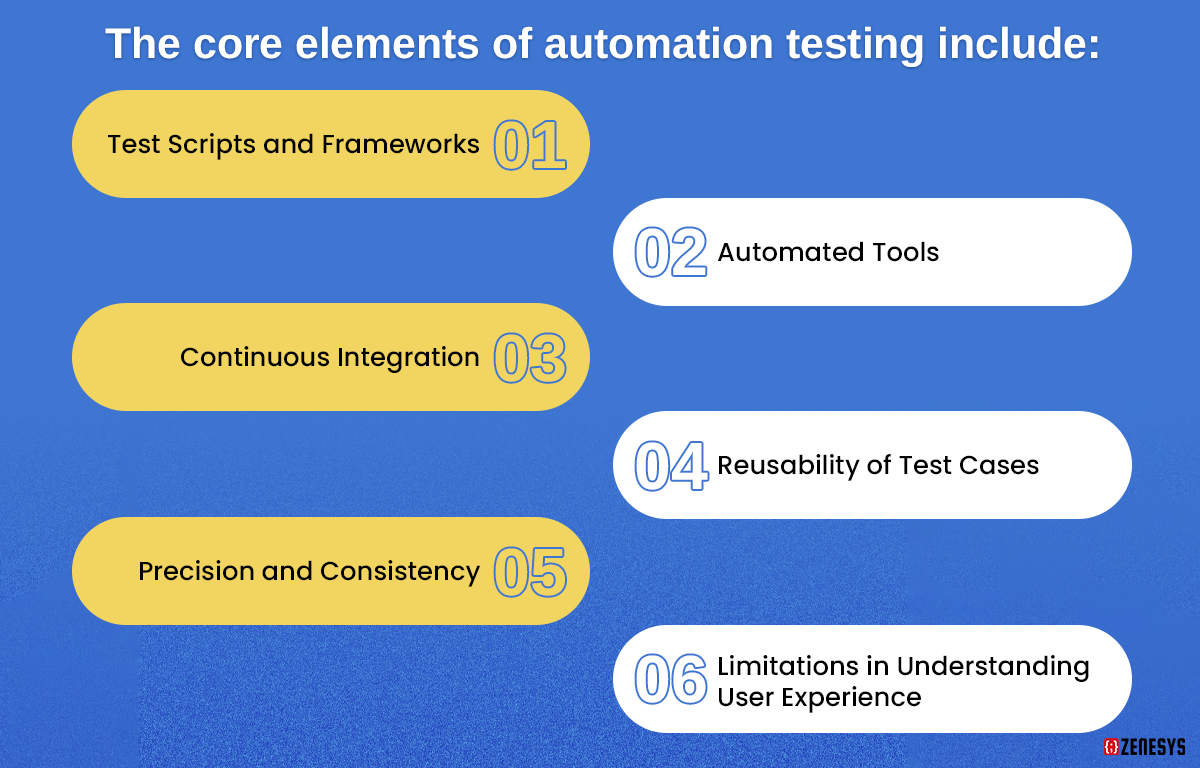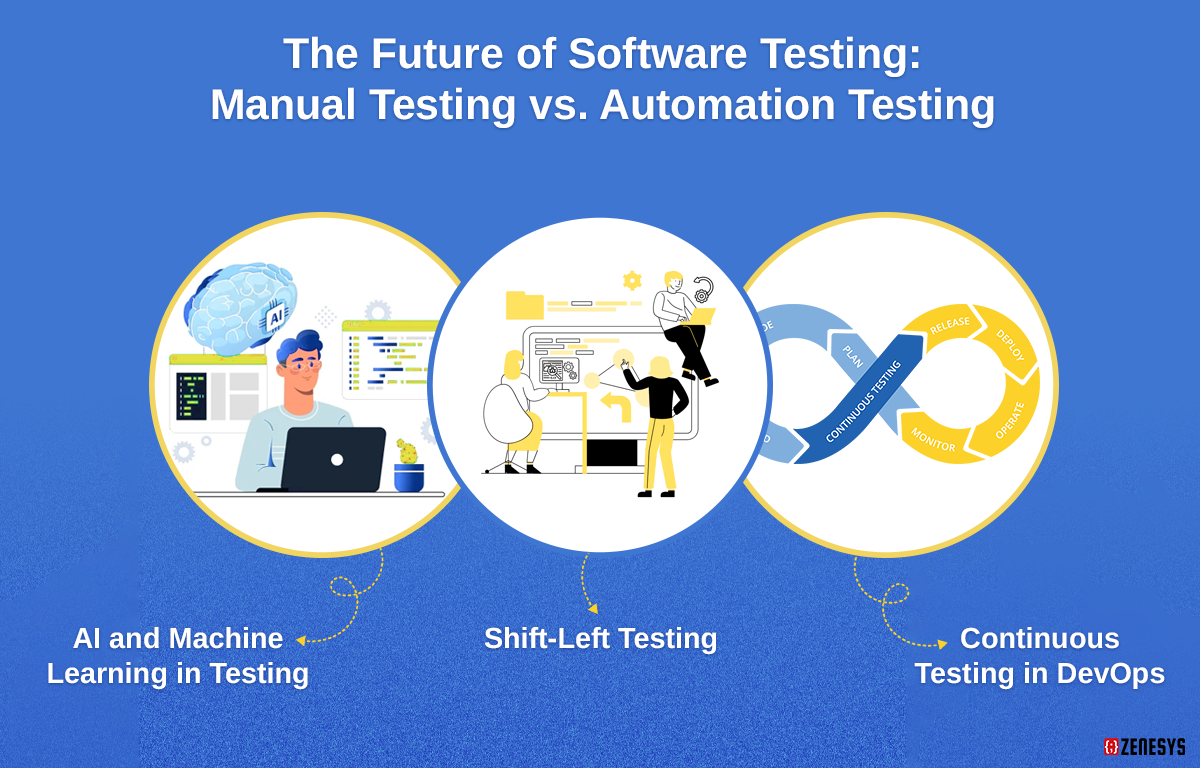Choosing the right testing method is important. The method you choose can significantly impact the quality, efficiency, and cost-effectiveness of the software development process. It's about striking the right balance between thorough testing and efficient use of resources.
In manual testing, the Leading Software Testing Service Provider plays a critical role, in executing the test cases and comparing the output to the expected behavior. They bring a human perspective to the process, which is especially important for understanding the user experience. This method is not just about finding bugs; it's about feeling the app from a user's perspective.
However, manual testing can be time-consuming and might only sometimes be consistent, as it relies on human effort. Testers might miss out on repetitive or complex tests, leading to errors slipping through. However manual testing is invaluable in scenarios where understanding the user's perspective is crucial, such as in user interface testing.
Definition of Manual Testing
Manual testing is a fundamental aspect of software quality assurance. It's the process where testers manually execute test cases without using any automated tools. In simpler terms, it's like a person going through a checklist to ensure everything in the software works as it's supposed to, just like a chef tasting their dish before serving it. It is generally used for Mobile App Testing.
The key characteristics of manual testing are:

Human Insight
The biggest strength of manual testing is the human element. Testers bring their intuition, understanding, and experience to the testing process. This is particularly valuable when assessing user-friendliness and the overall user experience of the software.
Flexibility
Manual testing is highly flexible. Testers can quickly adapt and change their approach based on the results they're seeing. This adaptability is vital, especially in the early stages of development when changes to the software are frequent.
No Need for Scripts or Tools
Unlike automated testing, manual testing doesn't require scripting or tools. This can be a significant advantage when testing complex or constantly changing user interfaces where writing automation scripts might be more time-consuming.
Cost-Effectiveness in Short-Term
For small projects or scenarios where the software is still evolving, manual testing can be more cost-effective. It doesn't involve the initial investment needed to set up automated testing tools.
Ideal for Exploratory Testing
Manual testing is perfect for exploratory testing, where the tester actively tries different things to find issues. This type of testing relies on the tester's creativity and insight, which can't be replicated by automated tools.
Immediate Feedback
Testers can provide immediate feedback to developers, which is invaluable during the development phase. This quick turnaround can speed up the process of fixing bugs and making improvements.
Limitations in Repetitive Tasks
Manual testing can be less effective for repetitive tasks. Leading software development companies find themselves in a monotonous task, leading to inconsistencies or oversights in long, repetitive testing sessions.
Worried About Bugs Slipping Through?
From functional testing to performance and automation, our QA experts make sure your product works flawlessly—before your users ever touch it.
Explore Our QA Testing ServicesExploring Automation Testing
Automation testing is like having a tireless, super-efficient robot handling the repetitive and time-consuming part of testing software. It involves using specialized tools to execute predefined test cases automatically, without any human intervention after the initial setup. Think of it as setting up a domino effect; once you flick the first one (start the test), it runs through the entire sequence on its own.
The core elements of automation testing include:

Test Scripts and Frameworks
At the center of automation testing are test scripts – sets of instructions that tell the testing tool what to do. These scripts are organized within frameworks that provide the structure and guidelines for automated testing, ensuring consistency and efficiency.
Automated Tools
These are the software that executes the test scripts. Tools like Selenium, QTP, and other automated testing tools enable the automation of web, mobile, and desktop application testing. They mimic user actions to check if the software behaves as expected.
Continuous Integration
Automation testing is a perfect fit for continuous integration in software development. It allows for the automatic testing of each code change, ensuring immediate feedback on potential issues, which is vital in Agile and DevOps practices.
Reusability of Test Cases
One of the major strengths of automation testing is the ability to reuse test cases across different versions of the software. Once a test script is created, it can be run multiple times over various iterations of the software, saving time and effort.
Precision and Consistency
Automated tests execute the same steps precisely every time they are run. This eliminates human error and ensures consistent results, making it ideal for regression testing and other repetitive tasks.
Limitations in Understanding User Experience
While automation excels in many areas, it cannot assess user experience factors like design, ease of use, or understanding complex user behaviors.
Also Read: What is Salesforce Sales Cloud? Top 10 Things You Need to Know About Salesforce
Manual Testing vs. Automation Testing: An In-Depth Comparison
Cost Factor
- Manual Testing : Initially, more cost-effective, manual testing doesn't require a significant upfront investment in tools or training. It's ideal for smaller projects or where frequent changes are expected. However, in the long run, the labor-intensive nature can increase costs, especially for large-scale projects.
- Automation Testing : Automation requires an initial investment in tools and setup, making it appear costly at the outset. However, over time, it proves cost-efficient for larger projects due to its reusability and speed, significantly reducing the cost per test in long-term projects.
Time and Efficiency
- Manual Testing: Manual testing is time-consuming, especially for large applications. It’s slower due to human involvement but provides the flexibility to quickly adapt to changes in the test cases or application.
- Automation Testing: Automation stands in its ability to execute tests quickly and repeatedly. Once set up, automated tests can run unattended, covering more ground in a shorter time, making it ideal for regression testing and large-scale projects.
Accuracy and Error Rates
- Manual Testing: While manual testing offers a personal touch, it's prone to human error, especially in repetitive tasks. Leading software development companies can overlook details or make mistakes, affecting the accuracy.
- Automation Testing: Automation provides high accuracy in test execution. It eliminates human error in repetitive tasks, ensuring consistency in results over multiple test cycles.
Scalability and Coverage
- Manual Testing: Manual testing has limitations in scalability. Testing large applications with complex scenarios can be challenging due to human limitations.
- Automation Testing: Automation excels in scalability. It can handle a large volume of tests and complex scenarios more efficiently than manual testing, offering broader coverage and more thorough testing.
Flexibility and Adaptability
- Manual Testing: Highly adaptable, manual testing allows for quick changes in test cases or testing approaches based on immediate observations and insights.
- Automation Testing: While automation is efficient, making changes to automated tests can be time-consuming, requiring updates in scripts and sometimes in the framework.
Skill Requirements
- Manual Testing: Manual testing requires less technical skill but more insight into user experience and understanding of the application from an end-user perspective.
- Automation Testing: Automation testing demands technical skills in scripting and understanding of automation tools and frameworks.
Applicability to Different Types of Testing
- Manual Testing: Ideal for exploratory, usability, and ad-hoc testing where human judgment is vital.
- Automation Testing: Best suited for regression, load, and performance testing where repetitive and consistent execution is required
Types of Projects Best Suited for Manual Testing
Early-Stage Startups/Prototypes
For startups in their early stages or prototypes, where frequent changes are the norm, manual testing is ideal. Quick, ad-hoc testing without the need for extensive scripting can adapt to rapid product evolution, providing immediate feedback.
Small-Scale Projects
Projects with limited scope or those that are short-term in nature benefit from manual testing. The absence of complex requirements or extensive test scenarios makes manual testing a cost-effective and practical choice.
Projects Requiring Human Intuition
Applications that heavily rely on user experience, like gaming or interactive media, need manual testing. Leading software development companies can provide insights on usability, aesthetics, and overall user satisfaction that automated tests cannot.
Exploratory Testing
Projects that require exploratory testing, where the goal is to uncover unknown issues or creative use cases, are best suited for manual testing. Testers can think out-of-the-box and explore different aspects of the application.
Complex UI Applications
Applications with complex and frequently changing user interfaces, such as websites or custom software, often require the nuanced understanding of a human tester to ensure that UI elements function as intended and are user-friendly.
Ideal Projects for Implementing Automation Testing
Large-Scale Enterprise Applications
Automation testing is perfect for large-scale enterprise applications with extensive functionalities. The ability to handle numerous test cases repeatedly makes it efficient for ensuring the application's stability over various updates and versions. To further strengthen application quality, integrating a SAST scan allows teams to catch security vulnerabilities early, combining functional reliability with robust code security.
Regression Testing
Projects that require frequent regression testing, where the same tests are repeated over different versions, benefit immensely from automation. It saves time and effort while maintaining consistency in testing.
Performance and Load Testing
For applications where performance under load is critical, such as e-commerce websites or cloud-based services, automation testing is essential. It can simulate thousands of users and scenarios, something impractical for manual testing.
Continuous Integration/Continuous Deployment (CI/CD) Pipelines
In CI/CD environments, where quick deployment is necessary, automation testing is vital. It ensures that new features or changes don't break the existing functionality, enabling rapid and reliable deployment cycles.
API and Backend Testing
Projects that involve extensive backend processing, like data management systems or APIs, are well-suited for automation testing solutions. Automated tests can efficiently validate data processing, logic, and integration across systems.
The Future of Software Testing: Manual Testing vs. Automation Testing

AI and Machine Learning in Testing
The integration of AI and ML in testing is revolutionizing the way we approach both manual and automated testing. AI can help identify patterns in application usage, which can then be used to focus manual testing efforts more effectively. Meanwhile, ML algorithms are being used to enhance automated testing tools, making them smarter in recognizing issues and reducing the time needed for test maintenance.
Shift-Left Testing
There's a growing trend towards 'shift-left' testing, where testing is integrated earlier in the development process. This approach ensures that both manual and automated testing are involved throughout the development lifecycle, catching defects early and reducing the cost and effort of fixing them later.
Continuous Testing in DevOps
In the DevOps model, continuous testing is becoming a standard. This involves automating the testing process as much as possible within the continuous integration/continuous deployment pipeline, while still relying on manual testing for specific, critical areas.
Integration of Manual Testing vs Automation Testing Shaping the Future
Balanced Approach
The future lies in a balanced approach where the strengths of both manual and automation testing are leveraged. While automation excels in efficiency and handling repetitive tasks, manual testing brings a human touch, especially valuable in user experience and usability testing.
Complementary Use
Automation is being used to handle the bulk of regression and routine testing, freeing up manual testers to focus on exploratory, usability, and ad-hoc testing. This complementary use ensures a more thorough and efficient testing process.
Collaborative Tools and Environments
We're seeing an increase in tools and environments that facilitate collaboration between manual and automated testing efforts. These tools help in managing test cases, tracking defects, and ensuring that both manual and automated tests are aligned and integrated.
Enhanced Quality and Speed
By combining manual insights with automated speed, leading software development companies can achieve higher quality at a faster pace. This integration is critical in meeting the demands of modern software development, where rapid deployment and high quality are both essential.
Conclusion
Manual testing, with its human insight and flexibility, is invaluable for exploratory, usability, and ad-hoc testing. It’s especially suited for scenarios where the human element is vital for assessing the user interface and overall user experience. On the other hand, automation testing stands out in its ability to efficiently handle large volumes of repetitive tasks with precision and consistency, making it ideal for regression, load, and performance testing in bigger and long-term projects.
The choice between manual testing vs automated testing should not be seen as an either/or decision but rather as a strategic selection based on the specific needs of your project. For early-stage or smaller projects, manual testing might be more suitable due to its lower initial costs and greater flexibility. Conversely, for larger-scale projects or those requiring frequent testing cycles, automation testing can provide significant long-term benefits in efficiency, speed, and cost-effectiveness.
Ultimately, the goal is to ensure the highest quality of the software. By understanding the strengths and limitations of both manual and automated testing, you can make informed decisions that best suit your project requirements, ensuring a successful and efficient software development process. Remember, the best testing strategy often involves a balanced combination of both manual and automated testing techniques.



.webp?lang=en-US&ext=.webp)

.webp?lang=en-US&ext=.webp)

